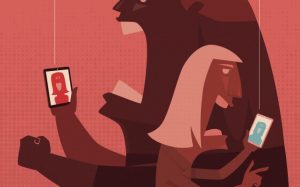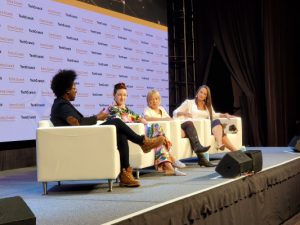The alien glare of bioluminescent bacteria bathes David Ishee’s face in green as he holds a petri dish over an LED light. Around him, the thick Mississippi gloom swallows the plywood walls of the shed where Ishee spends nights and weekends trying to cut and paste a jellyfish gene into the sperm of one of his 150-pound male mastiffs. The full-time oil plant operator, part-time dog breeder/biohacker is trying to make glow-in-the-dark puppies.
“I had assumed that getting DNA and making changes cost millions of dollars, and that you needed a huge lab and a research team and all that stuff,” he says. “But you’d be surprised what you can find on YouTube.”
This is the opening scene of Unnatural Selection, Netflix’s provocative new docuseries about Crispr gene-editing technology, which premieres today on the streaming platform. But don’t let the canine masturbation scenes and self-experimentation soapboxing scare you off. Ishee is just one character among many you’ll meet in four fast-paced, hour-long episodes, a bit player in a global drama unfolding over who gets to wield the awesome power of Crispr.
Filmed between 2016 and 2018, Unnatural Selection chronicles the ambitions and struggles of scientists, doctors, patients, conservationists, and biohackers as they seek to wrest control of evolution from nature itself. They are all navigating the profound ethical dilemmas of a world where it’s possible to rewrite the code of life inside any organism, including humans. “The common thread between all the characters is that they’re in possession of tomorrow’s technology, but they’re stuck in the systems of today,” says Leeor Kaufman, who created the show along with Joe Egender.
When Egender first told his collaborator about Crispr, Kaufman assumed this an idea for a sci-fi film. It was 2015, and Egender had just read an article about the nascent technology. He remembered looking around the subway car, wondering if anyone else knew about it. “I was shook, I just had no idea,” says Egender. “I’d never heard anyone talking about it.” Together, he and Kaufman set out to change that.
It’s hard to wrestle with a technology that, for most people, exists only in headlines, if at all. That’s where Unnatural Selection offers even those very familiar with Crispr something powerful and new. It opens up a window into the often invisible debates in village squares and doctors’ offices.
Perhaps nowhere is this access more arresting than in the show’s third installment, which explores the concept of gene drive—a technique that uses Crispr to “drive” a genetic change through a population at evolutionary warp speed. Its inventor, an MIT engineer named Kevin Esvelt, spends the episode flying around the world, pitching it as a way to erase Lyme disease, say, from the tick-infested parts of Massachusetts or to exterminate invasive rodents in New Zealand. At a meeting with Maori elders, Esvelt is attacked for taking funding from Darpa, the Defense Advanced Research Projects Agency. “We’ve heard lots and lots of nice words from the colonizers over the millennia that have proven to be hollow,” said one man. “You’re a little bit like the missionary who comes along with a good story, but behind you are a whole lot of men with rifles.”
These moments of suspicion and fear arise throughout the episode, including in street protests in Burkina Faso, where thousands marched against a proposal to release gene-drive mosquitoes in that country as a way to eradicate malaria. But just when Unnatural Selection has you convinced that this technology is too new, too dangerous to be let loose on the world, it drops you into a clinic in a rural village, where every person comes down with malaria at least once a year—sometimes taking their lives, especially the young ones. “At the human level, we are the ones suffering from this thing,” says Abdoulaye Diabate, a medical entomologist who grew up in Burkina Faso and is leading some gene-drive experiments there. Bearing the burden of malaria no longer has to be the fate of Africa, he adds. Not when the technology to eliminate the disease exists.
Yet the episodes can also seem frenetic without a narrator at the helm, as when the first episode jumps between the labs of various scientists and the Oakland garage of the Odin’s Josiah Zayner. If you were looking for a Schoolhouse Rock explanation of how Crispr works or a deep dive on the history of its discovery, Unnatural Selection won’t deliver. And it can muddy the distinctions between various technologies, as Crispr, gene editing, gene therapy, and genetic engineering all get thrown around. The second episode, for example, features two families seeking astronomically expensive new gene therapies. Neither are Crispr-based medicines, though the families’ struggle for access offer a hint of what’s to come when such medicines eventually arrive.
Like any good series, the most compelling moments come in the final episode, which examines the most controversial use of Crispr—editing human embryos to pass changes on to future generations. The couples who bring the specter of designer babies to life do so using today’s fertility techniques. In one scene, a fertility doctor helps his patients pick out embryos that are likely to become babies boasting the same blue eyes as their mother. In another, a Ukrainian couple delivers a healthy baby boy—with 23 chromosomes from his mother, 23 chromosomes from his father, and mitochondrial DNA from another woman, the product of three-parent IVF.
It’s in this episode too that Ishee emerges as more than a ponytailed dog semen savant. As he sees his biohacking friends accelerate a reckless attempt to create and commercialize a home HIV cure using Crispr, his confidence in their altruistic ambitions begins to erode. Egender and Kauffman’s cameras capture these moments of fracture and ultimately, failure, with unsentimental lucidity. It’s a refreshing dose of reality after so much spectacle.
That’s not to say that the show’s subjects completely avoid falling into sci-fi tropes. All the requisite references will be made—to Gattaca, to Huxley, to “life, uh, finds a way.” But in the end, watching them confront their hopes and fears for what kind of world Crispr might make is a humbling and grounding experience. After watching Unnatural Selection you might not have a better understanding of how Crispr-Cas9 differs from Crispr-Cas12e, a, or b, but you’ll definitely have something to talk about on the subway.
More Great WIRED Stories
- WIRED25: Stories of people who are racing to save us
- Massive, AI-powered robots are 3D-printing entire rockets
- Ripper—the inside story of the egregiously bad videogame
- USB-C has finally come into its own
- Planting tiny spy chips in hardware can cost as little as $200
- 👁 Prepare for the deepfake era of video; plus, check out the latest news on AI
- 🏃🏽♀️ Want the best tools to get healthy? Check out our Gear team’s picks for the best fitness trackers, running gear (including shoes and socks), and best headphones.


